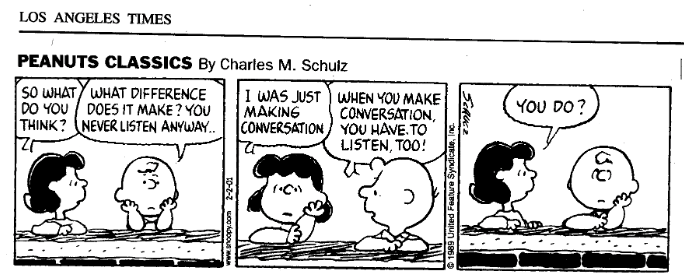One of the most important things a sales person can do with her customer is to “understand.” One of the most important things great leaders do is to try to “understand.”
Instead, we tend to focus, selfishly, on being “understood.” That is, focusing on our own priorities, self interests, agendas and what we seek to achieve.
Dr. Stephen Covey’s fifth habit, “Seek first to understand, then to be understood,” is a fundamental principle of selling and leadership, yet it is rare that I see this principle exercised.
Until we understand our customers–individually and organizationally, we have no context in which we might be understood. Until we invest the time and caring to understand, why should we expect the customer to invest their time and caring to understand–when we seek to be understood.
Understanding is far more than learning something like “BANT.” It’s far more than understanding their needs, requirements, budgets. Understanding is more than getting the information to do a demo or provide a quote.
Understanding requires us to understand our customers’ markets, industries, drivers, and businesses. Without this, we can’t understand what our customers face in doing their jobs. Without this, we can’t help them innovate, change, or recognize opportunities to improve. Without this, we can’t create value with them.
Understanding requires us to understand our customers as human beings. They are not widgets to be passed from sales specialist to sales specialist down our sales assembly line. They have hopes, dreams, goals, fears. They are overwhelmed, they are confused. They want to choose well, but don’t know what that means. We cannot connect with our customers, helping them move forward until we first understand.
Our act of understanding also helps the customer understand. It helps them discover what they may not know, but need to. It helps them understand what, how, why they might change. It helps them get greater clarity on issues which were unknown or previously unclear. It helps them understand where they are, where they might go, and why that might be important.
Understanding and caring go hand in hand. I suspect, too often, we don’t take the time to understand, because we really don’t care.
Understanding may also require us to shift our own point of view. In seeking to understand, we may discover how much we have misunderstood.
Understanding is actually a collaborative effort. The more we seek to understand, the more others open themselves to understanding.
Once we understand, we can now seek to be understood. But we do so from in a much more impactful way. We have a context, we know how to focus, we understand what’s most critical, we understand what the challenges and roadblocks are, we understand how people feel and why they feel that way.
Understanding enables all of us to enter into collaborative two way conversations. Understanding provides us the basis for agreeing on change and moving forward.
If we could do one thing to more effectively engage our customers, we should throw out all the tools, techniques, gimmicks that we inflict on ourselves and our customers.
The only thing we need to master is to “Seek first to understand…..” Once we do this, we and our customers can move forward, together.
Seeking to understand is a characteristic of great leaders. Of course great leaders recognize their people are their “customers,” so they apply all the principles I’ve discussed. If you are a manager, what are you doing to understand your people?

Thank you Dave – Your comment refers – “we dont take the time to understand because we don’t really care”.I agree strongly having practiced and coached the Stephen Covey principle for the past 25 years. Nevertheless a segment/percentage of service providers AND leaders simply do not understand the powerful importance of the principle. Some believe they are good listeners anyway and most will certainly not read the 2 books I noticed in my local bookshop yesterday 21 March 2021- both exclusively about the importance of listening skill